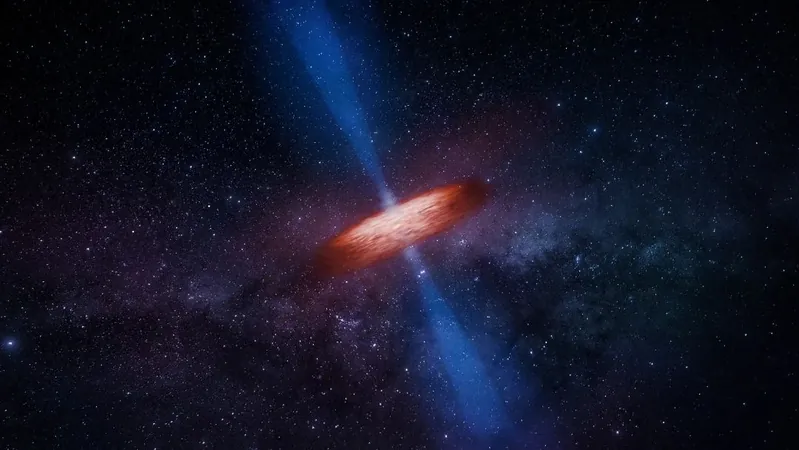
Groundbreaking Discoveries: Astronomers Unlock Secrets of Black Hole Jets with Event Horizon Telescope
2025-01-12
Author: Liam
Introduction
In a thrilling advancement in astrophysics, astronomers are delving deep into the mysteries surrounding supermassive black holes, not only focusing on these cosmic giants but also studying the immense jets they emit at near-light speeds. These colossal jets can stretch across millions of light-years, leaving many to wonder: what mechanisms drive their creation and acceleration?
The Role of the Event Horizon Telescope
A team of dedicated researchers, spearheaded by Anne-Kathrin Baczko from the esteemed Chalmers University of Technology in Sweden, has identified a promising tool in their quest for answers—the Event Horizon Telescope (EHT). This extraordinary array, which consists of eight ground-based radio telescopes working in unison across the globe, offers unprecedented insights into the enigmatic behavior of black holes.
Targeting NGC 1052
In a groundbreaking effort, the EHT team first set their sights on the galaxy NGC 1052 in 2017, a distant celestial object located approximately 60 million light-years away in the constellation of Cetus. Here lies a supermassive black hole with a staggering mass exceeding 150 million times that of our sun, launching powerful bipolar jets that extend outwards from its core.
Challenges and Breakthroughs
While NGC 1052 presented a tantalizing target for EHT imaging, Baczko admitted that the task was daunting due to the faint and complex nature of the galaxy's center. 'For such a faint and unknown target, we were not sure if we would get any data at all—but the strategy worked,' she stated with evident excitement.
EHT's Observations
The team's findings reveal that the black hole at the heart of NGC 1052 emits exceptionally bright radio waves at a wavelength of one millimeter, a crucial bandwidth that the EHT exploits to produce incredibly detailed images. Their observations were recently shared in a paper published in the prestigious journal Astronomy & Astrophysics.
Future Prospects
Notably, NGC 1052's emissions become even more pronounced at slightly longer wavelengths, making it an excellent candidate for upcoming radio telescopes. Instruments like the next-generation Very Large Array in New Mexico and an expanded version of the Event Horizon Telescope are set to enhance our observational capabilities significantly. Astronomers are hopeful that these advancements will allow them to not only capture high-resolution images but also record videos of black holes in action.
Comparative Analysis with M87*
In an intriguing comparison, the researchers discovered that the dusty environment surrounding the black hole jets in NGC 1052 is comparable in size to the ring surrounding the notorious supermassive black hole M87*. This black hole gained fame in 2019 as the first to be directly imaged by the EHT, famously resembling a fuzzy orange donut. The similarities in size indicate that the region around NGC 1052 is substantial enough to be effectively imaged with the EHT at peak performance.
Conclusion
As the quest for knowledge around black holes continues, the use of innovative technology and international collaboration holds promise for revealing even more of the universe's secrets. Are we on the brink of unveiling the complex mechanisms of these cosmic phenomena? Only time and further research will tell, but one thing is for certain: the fascination with black holes has only just begun. Stay tuned for more discoveries that could change our understanding of the universe forever!









 Brasil (PT)
Brasil (PT)
 Canada (EN)
Canada (EN)
 Chile (ES)
Chile (ES)
 Česko (CS)
Česko (CS)
 대한민국 (KO)
대한민국 (KO)
 España (ES)
España (ES)
 France (FR)
France (FR)
 Hong Kong (EN)
Hong Kong (EN)
 Italia (IT)
Italia (IT)
 日本 (JA)
日本 (JA)
 Magyarország (HU)
Magyarország (HU)
 Norge (NO)
Norge (NO)
 Polska (PL)
Polska (PL)
 Schweiz (DE)
Schweiz (DE)
 Singapore (EN)
Singapore (EN)
 Sverige (SV)
Sverige (SV)
 Suomi (FI)
Suomi (FI)
 Türkiye (TR)
Türkiye (TR)
 الإمارات العربية المتحدة (AR)
الإمارات العربية المتحدة (AR)